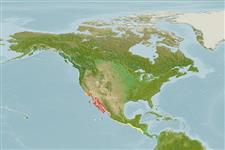Environment: milieu / climate zone / depth range / distribution range
экология
морской ассоциированный с рифами; пределы глубины 1 - 61 m (Ref. 2850). Subtropical; 37°N - 10°N, 123°W - 85°W
Eastern Central Pacific: Monterey in California, USA to Mexico, including the Gulf of California. Also reported in Nicaragua (Ref. 13613).
Length at first maturity / Size / Вес / Возраст
Maturity: Lm ?, range 9 - ? cm
Max length : 60.0 cm TL самец/пол неопределен; (Ref. 26550); наибольший вес (опубликованные данные): 900.00 g (Ref. 40637); наибольший возраст (опубликованны данные): 20 годы (Ref. 56049)
Usually found on sand or mud bottom near rocks and eelgrass, from the coast to a depth of 60 m. A secretive species, it feeds on small fishes and benthic crustaceans during the day (Ref. 9342). Capable of tolerating ample fluctuations of temperature (from 7.5 to 32°C) and survive extreme cold intervals (Ref. 9342). Pelagic spawners (Ref. 56049). Important game fish caught in bays and harbors (Ref. 9342). Minimum depth range based on occurrence (Ref. 79604).
Pelagic spawner (Ref. 56049). Protogyny (Ref. 32126) as proposed has been corrected by a more detailed study on several species which confirmed this species and all of the members of the genus to be gonochoristic (Ref. 103751).
Eschmeyer, W.N., E.S. Herald and H. Hammann, 1983. A field guide to Pacific coast fishes of North America. Boston (MA, USA): Houghton Mifflin Company. xii+336 p. (Ref. 2850)
Статус Красного Списка МСОП (Ref. 130435)
Угроза для людей
Harmless
Использование человеком
рыболовство: интереса не представляет; объект спортивного рыболовства: да
дополнительная информация
инструменты
Специальные отчеты
Скачать в формате XML
ресурсы в Интернет
Estimates based on models
Preferred temperature (Ref.
123201): 18.1 - 26.8, mean 22.3 °C (based on 42 cells).
Phylogenetic diversity index (Ref.
82804): PD
50 = 0.5020 [Uniqueness, from 0.5 = low to 2.0 = high].
Bayesian length-weight: a=0.01288 (0.00809 - 0.02051), b=3.00 (2.88 - 3.12), in cm total length, based on LWR estimates for this species & Genus-body shape (Ref.
93245).
Trophic level (Ref.
69278): 4.1 ±0.56 se; based on food items.
Generation time: 3.7 ( na - na) years. Estimated as median ln(3)/K based on 1
growth studies.
устойчивость к внешним воздействиям (Ref.
120179): средний (среднего размера), минимальное время удвоения популяции 1.4-4.4 года (tm=1.5; tmax=20; K=0.296).
Fishing Vulnerability (Ref.
59153): Moderate vulnerability (37 of 100).
Nutrients (Ref.
124155): Calcium = 20.5 [11.6, 42.9] mg/100g; Iron = 0.556 [0.279, 0.979] mg/100g; Protein = 19.4 [17.5, 21.0] %; Omega3 = 0.224 [0.132, 0.376] g/100g; Selenium = 16.4 [8.6, 32.5] μg/100g; VitaminA = 73.5 [24.6, 256.6] μg/100g; Zinc = 0.566 [0.368, 0.879] mg/100g (wet weight);
